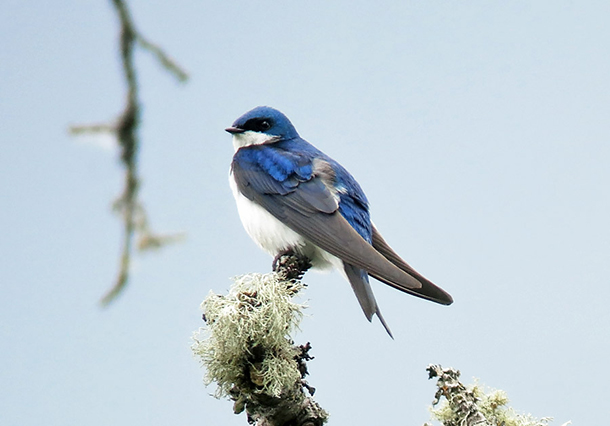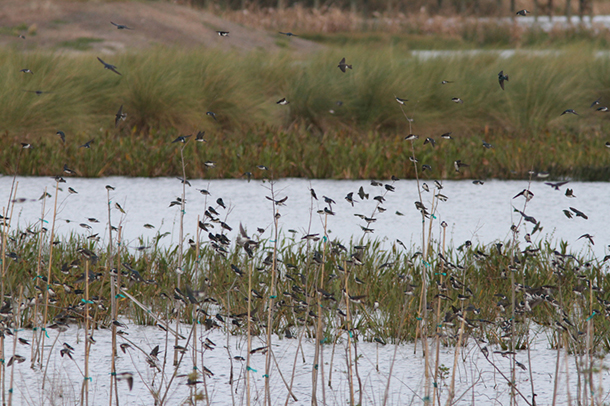BirdNote®: Roosting Tree Swallows
Air Date: Week of September 22, 2017

During the Northern Hemisphere’s summer, tree swallows inhabit much of the Western and Northern United States and most of Canada. But come fall, these birds migrate to the Gulf Coast, the Caribbean, and Central America. (Photo: Mike Hamilton, CC)
On September 22 Fall arrived in the Northern Hemisphere, and millions of singing Tree Swallows will soon fly south. But for now, explains BirdNote’s Mary McCann, these summer performers are staging their final shows of the season.
Transcript
[MUSIC: BIRDNOTE THEME]
CURWOOD: Here on the east coast of the US the autumnal equinox came shortly after four in the afternoon on September 22, and the days are growing noticeably shorter. But many of the songsters of summer are still with us and as Mary McCann points out in today’s BirdNote, they continue to put on spectacular shows.
BirdNote®
Tree Swallow Roost –
The Swarm in Connecticut
[MULTIPLE TREE SWALLOWS CALLING; WAVES LAPPING AGAINST A BOAT]
As the sun sets over the Connecticut River, an astounding natural spectacle unfolds. As many as
300,000 sparkling blue swallows—Tree Swallows—wing their way from miles around, to roost for
the evening on Goose Island, near Old Lyme.
[MULTIPLE TREE SWALLOWS CALLING; WAVES LAPPING AGAINST A BOAT]
The birds gather on the wing in one immense, tightly choreographed flock, a swirling mass that
changes shape from one second to the next, like an immense silken banner or plume of smoke racing
with the wind. With dusk at hand, the aerobatic flock – now shaped like a tornado – swoops down into
the island’s tall reeds. It takes but 15 seconds for the 300,000 birds to vanish into the marsh, where they
remain until dawn.
[CALL OF TREE SWALLOW FLOCK]

Tree Swallows travel in massive flocks. On a recent, late-summer evening, around 300,000 of them gathered from miles around to roost on Goose Island in Connecticut. (Photo: Dan Irizzary, CC)
Roger Tory Peterson, dean of American birdwatching, wrote of the swallows: “I have seen a million
flamingos on the lakes of East Africa and as many seabirds on the cliffs of the Alaska Pribilofs, but for
sheer drama, the tornadoes of tree swallows eclipsed any other avian spectacle I have ever seen." *
[TREE SWALLOWS CALLING]
Soon all of Goose Island’s swallows will disappear below the southern horizon for the winter. But
witnesses will long remember the autumnal spectacle of the birds’ massed flight.
[TREE SWALLOWS CALLING]
Tree Swallows coast to coast are swirling down to roost this month. Maybe there’s a roost near you.
I’m Mary McCann.
###
Written by Bob Sundstrom
Call of Tree Swallow flock provided by The Macaulay Library at the Cornell Lab of Ornithology, Ithaca, New York. Song recorded by
G.F. Budney. Massive flock sounds recorded by O.H. Hewitt.
Producer: John Kessler
Executive Producer: Chris Peterson
© 2008-2017 Tune In to Nature.org September 2017 Narrator: Mary McCann
Tree Swallow photo by Dan Dzurisin https://www.flickr.com/photos/ndomer73/2544385868/
Tree Swallows coming to roost, by Dan Irizarry https://www.flickr.com/photos/danirizarry/6628440837/
*Peterson quotation taken from RiverQuest tour ad for swallow trips.
CURWOOD: And for photos, try our roost, the website loe dot org.
Links
Living on Earth wants to hear from you!
Living on Earth
62 Calef Highway, Suite 212
Lee, NH 03861
Telephone: 617-287-4121
E-mail: comments@loe.org
Newsletter [Click here]
Donate to Living on Earth!
Living on Earth is an independent media program and relies entirely on contributions from listeners and institutions supporting public service. Please donate now to preserve an independent environmental voice.
NewsletterLiving on Earth offers a weekly delivery of the show's rundown to your mailbox. Sign up for our newsletter today!
 Sailors For The Sea: Be the change you want to sea.
Sailors For The Sea: Be the change you want to sea.
 The Grantham Foundation for the Protection of the Environment: Committed to protecting and improving the health of the global environment.
The Grantham Foundation for the Protection of the Environment: Committed to protecting and improving the health of the global environment.
 Contribute to Living on Earth and receive, as our gift to you, an archival print of one of Mark Seth Lender's extraordinary wildlife photographs. Follow the link to see Mark's current collection of photographs.
Contribute to Living on Earth and receive, as our gift to you, an archival print of one of Mark Seth Lender's extraordinary wildlife photographs. Follow the link to see Mark's current collection of photographs.
 Buy a signed copy of Mark Seth Lender's book Smeagull the Seagull & support Living on Earth
Buy a signed copy of Mark Seth Lender's book Smeagull the Seagull & support Living on Earth

